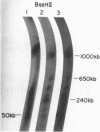Abstract
The gene for Huntington disease (HD) has been localized to the distal portion of the short arm of human chromosome 4 by linkage analysis. Currently, the two closest DNA markers are D4S10 (G8), located approximately equal to 3 centimorgans centromeric to HD, and D4S43 (C4H), positioned 0-1.5 centimorgans from HD. In an effort to move closer to the HD gene, with the eventual goal of identifying the gene itself, we have applied the technique of chromosome jumping to this region. A 200-kilobase jumping library has been constructed, and a jump from D4S10 has been obtained and its approximate distance verified by pulsed field gel electrophoresis. Two restriction fragment length polymorphisms have been identified at the jump locus, which is denoted D4S81. Linkage analysis of previously identified recombinants between D4S10 and HD or D4S10 and D4S43 shows that in two of five events the jump has crossed the recombination points. This unequivocally orients D4S10 and D4S81 on the chromosome, provides additional markers for HD, and suggests that recombination frequency in this region of chromosome 4 may be increased, so that the physical distance from D4S10 to HD may not be as large as originally suspected.
Full text
PDF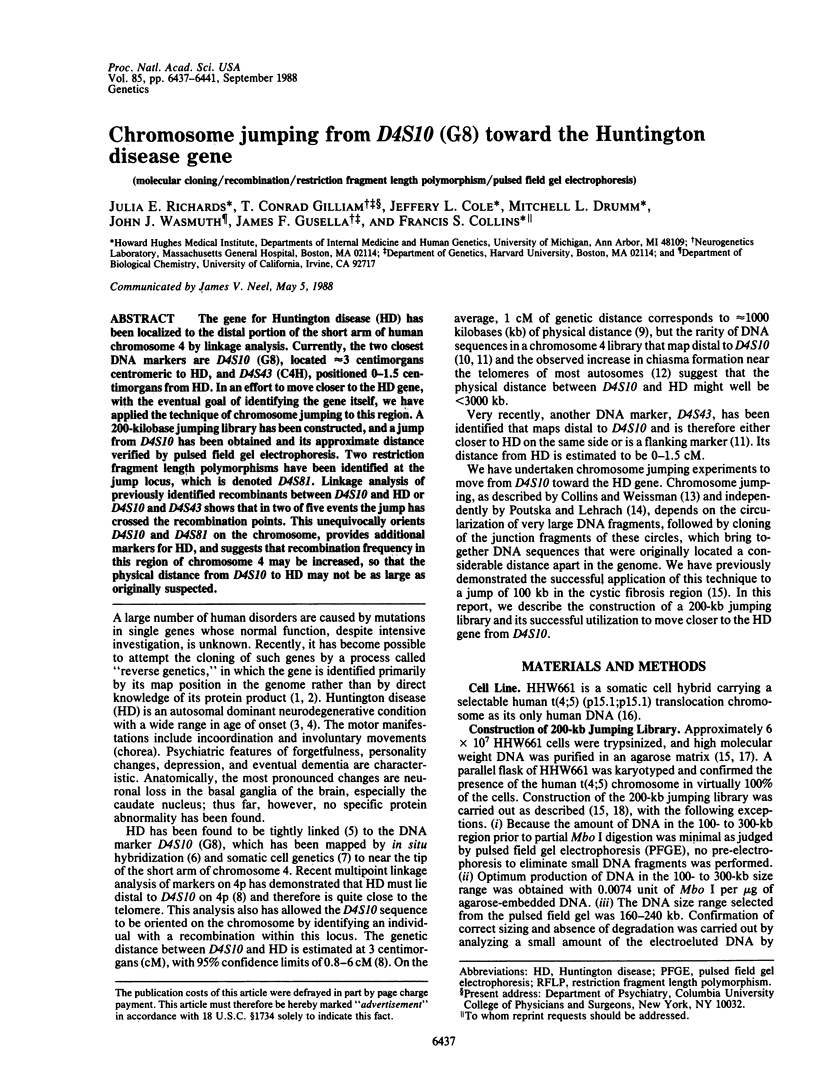
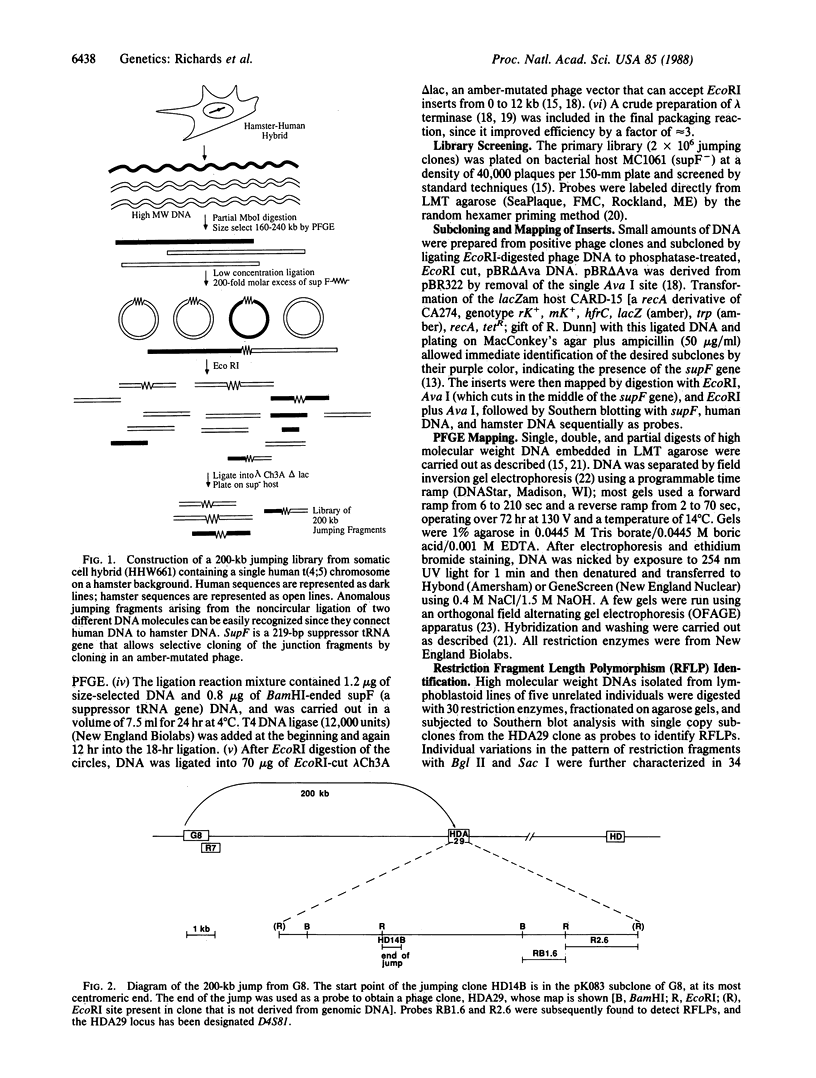
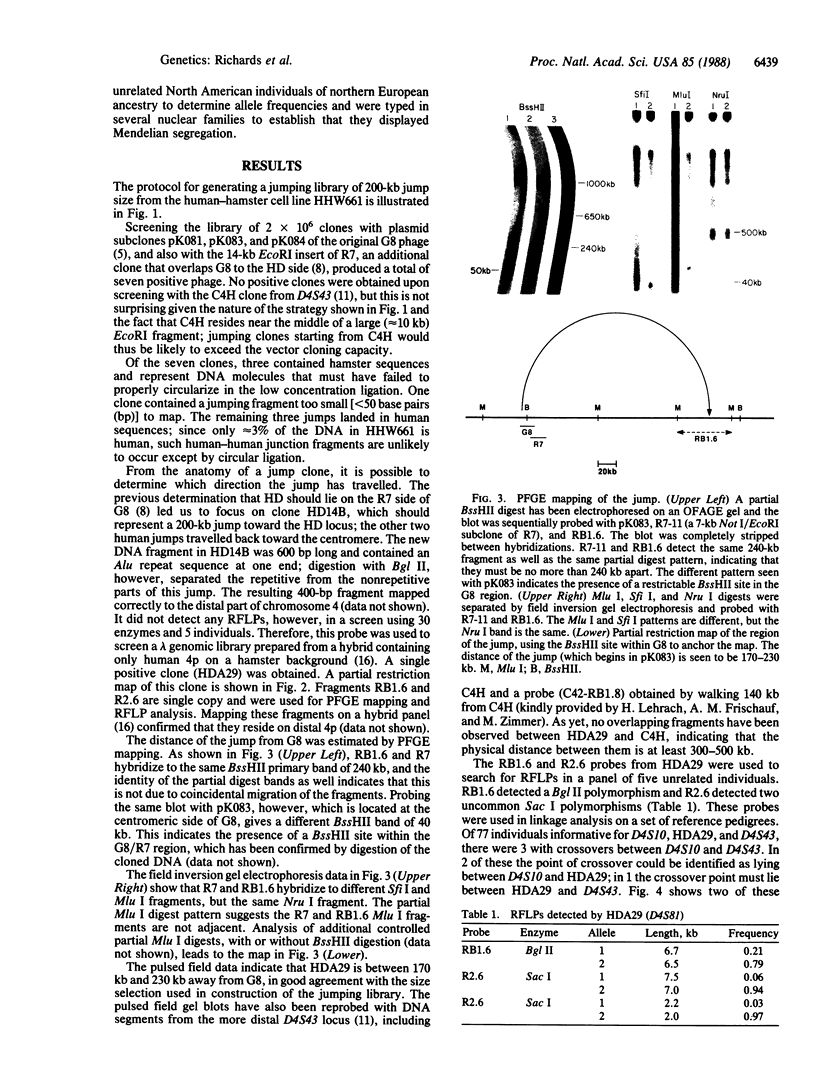
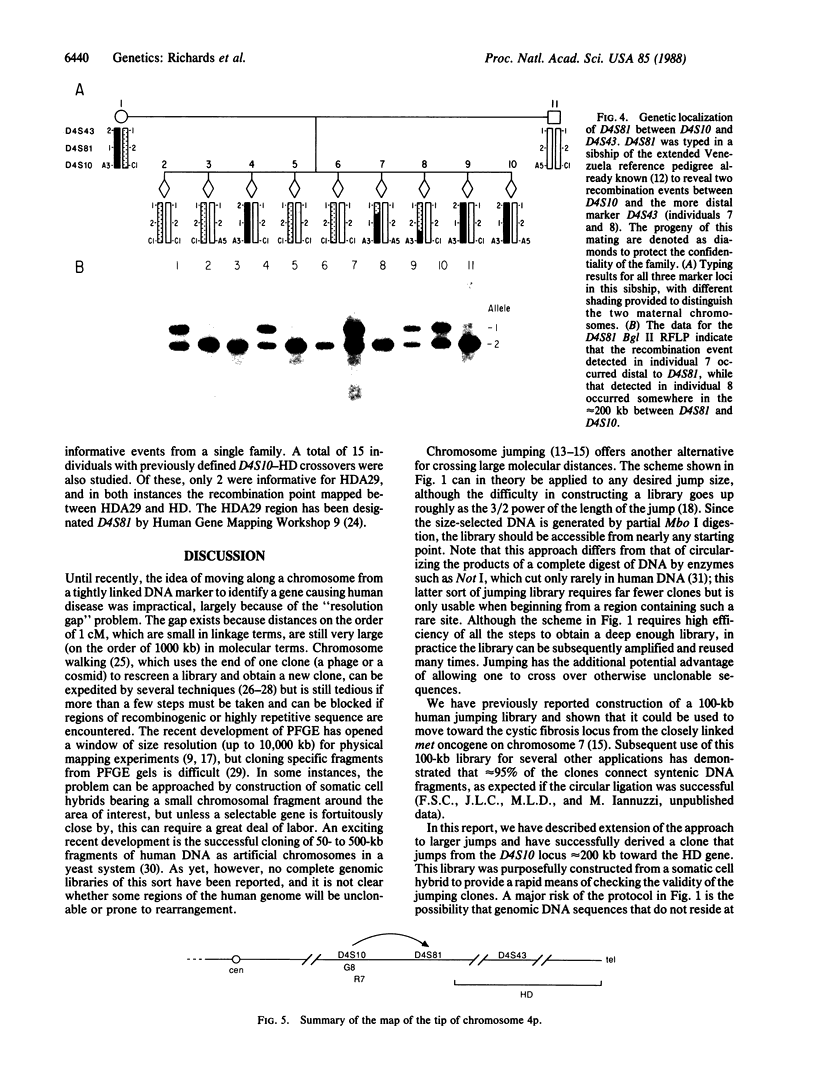
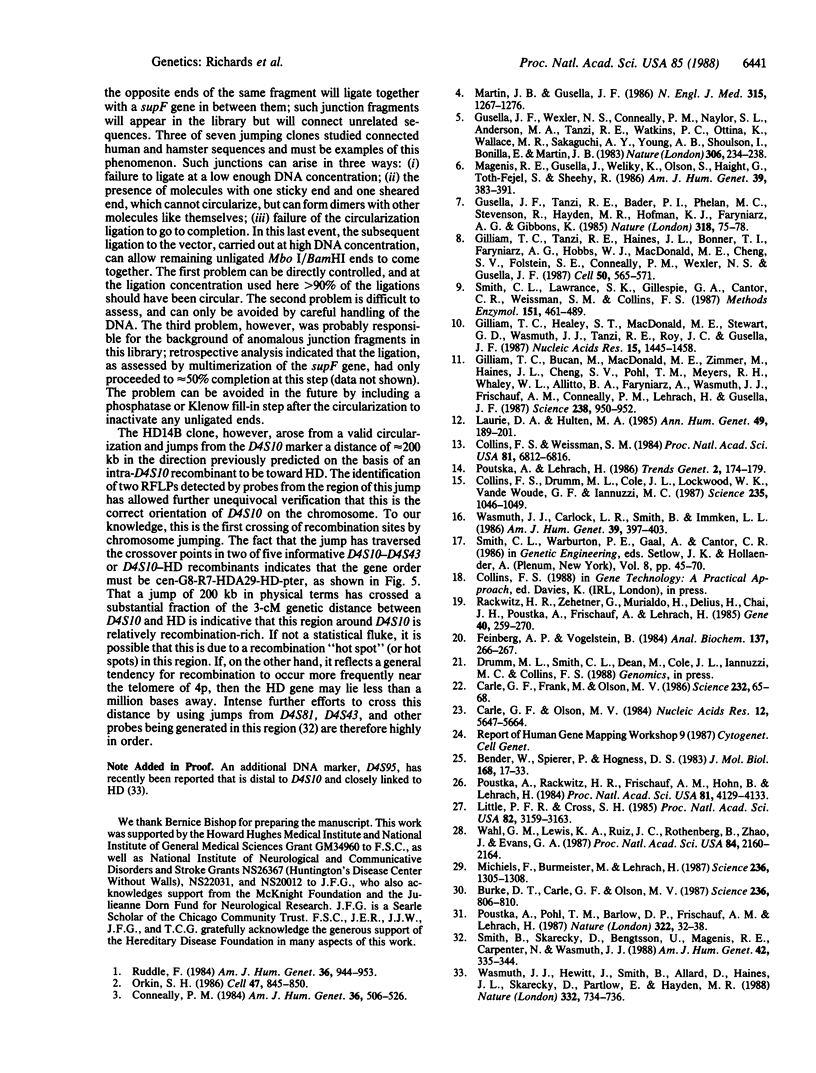
Images in this article
Selected References
These references are in PubMed. This may not be the complete list of references from this article.
- Bender W., Spierer P., Hogness D. S. Chromosomal walking and jumping to isolate DNA from the Ace and rosy loci and the bithorax complex in Drosophila melanogaster. J Mol Biol. 1983 Jul 25;168(1):17–33. doi: 10.1016/s0022-2836(83)80320-9. [DOI] [PubMed] [Google Scholar]
- Burke D. T., Carle G. F., Olson M. V. Cloning of large segments of exogenous DNA into yeast by means of artificial chromosome vectors. Science. 1987 May 15;236(4803):806–812. doi: 10.1126/science.3033825. [DOI] [PubMed] [Google Scholar]
- Carle G. F., Frank M., Olson M. V. Electrophoretic separations of large DNA molecules by periodic inversion of the electric field. Science. 1986 Apr 4;232(4746):65–68. doi: 10.1126/science.3952500. [DOI] [PubMed] [Google Scholar]
- Carle G. F., Olson M. V. Separation of chromosomal DNA molecules from yeast by orthogonal-field-alternation gel electrophoresis. Nucleic Acids Res. 1984 Jul 25;12(14):5647–5664. doi: 10.1093/nar/12.14.5647. [DOI] [PMC free article] [PubMed] [Google Scholar]
- Collins F. S., Drumm M. L., Cole J. L., Lockwood W. K., Vande Woude G. F., Iannuzzi M. C. Construction of a general human chromosome jumping library, with application to cystic fibrosis. Science. 1987 Feb 27;235(4792):1046–1049. doi: 10.1126/science.2950591. [DOI] [PubMed] [Google Scholar]
- Collins F. S., Weissman S. M. Directional cloning of DNA fragments at a large distance from an initial probe: a circularization method. Proc Natl Acad Sci U S A. 1984 Nov;81(21):6812–6816. doi: 10.1073/pnas.81.21.6812. [DOI] [PMC free article] [PubMed] [Google Scholar]
- Conneally P. M. Huntington disease: genetics and epidemiology. Am J Hum Genet. 1984 May;36(3):506–526. [PMC free article] [PubMed] [Google Scholar]
- Feinberg A. P., Vogelstein B. "A technique for radiolabeling DNA restriction endonuclease fragments to high specific activity". Addendum. Anal Biochem. 1984 Feb;137(1):266–267. doi: 10.1016/0003-2697(84)90381-6. [DOI] [PubMed] [Google Scholar]
- Gilliam T. C., Bucan M., MacDonald M. E., Zimmer M., Haines J. L., Cheng S. V., Pohl T. M., Meyers R. H., Whaley W. L., Allitto B. A. A DNA segment encoding two genes very tightly linked to Huntington's disease. Science. 1987 Nov 13;238(4829):950–952. doi: 10.1126/science.2890209. [DOI] [PubMed] [Google Scholar]
- Gilliam T. C., Healey S. T., MacDonald M. E., Stewart G. D., Wasmuth J. J., Tanzi R. E., Roy J. C., Gusella J. F. Isolation of polymorphic DNA fragments from human chromosome 4. Nucleic Acids Res. 1987 Feb 25;15(4):1445–1458. doi: 10.1093/nar/15.4.1445. [DOI] [PMC free article] [PubMed] [Google Scholar]
- Gilliam T. C., Tanzi R. E., Haines J. L., Bonner T. I., Faryniarz A. G., Hobbs W. J., MacDonald M. E., Cheng S. V., Folstein S. E., Conneally P. M. Localization of the Huntington's disease gene to a small segment of chromosome 4 flanked by D4S10 and the telomere. Cell. 1987 Aug 14;50(4):565–571. doi: 10.1016/0092-8674(87)90029-8. [DOI] [PubMed] [Google Scholar]
- Gusella J. F., Tanzi R. E., Bader P. I., Phelan M. C., Stevenson R., Hayden M. R., Hofman K. J., Faryniarz A. G., Gibbons K. Deletion of Huntington's disease-linked G8 (D4S10) locus in Wolf-Hirschhorn syndrome. Nature. 1985 Nov 7;318(6041):75–78. doi: 10.1038/318075a0. [DOI] [PubMed] [Google Scholar]
- Gusella J. F., Wexler N. S., Conneally P. M., Naylor S. L., Anderson M. A., Tanzi R. E., Watkins P. C., Ottina K., Wallace M. R., Sakaguchi A. Y. A polymorphic DNA marker genetically linked to Huntington's disease. Nature. 1983 Nov 17;306(5940):234–238. doi: 10.1038/306234a0. [DOI] [PubMed] [Google Scholar]
- Laurie D. A., Hultén M. A. Further studies on bivalent chiasma frequency in human males with normal karyotypes. Ann Hum Genet. 1985 Jul;49(Pt 3):189–201. doi: 10.1111/j.1469-1809.1985.tb01693.x. [DOI] [PubMed] [Google Scholar]
- Little P. F., Cross S. H. A cosmid vector that facilitates restriction enzyme mapping. Proc Natl Acad Sci U S A. 1985 May;82(10):3159–3163. doi: 10.1073/pnas.82.10.3159. [DOI] [PMC free article] [PubMed] [Google Scholar]
- Magenis R. E., Gusella J., Weliky K., Olson S., Haight G., Toth-Fejel S., Sheehy R. Huntington disease-linked restriction fragment length polymorphism localized within band p16.1 of chromosome 4 by in situ hybridization. Am J Hum Genet. 1986 Sep;39(3):383–391. [PMC free article] [PubMed] [Google Scholar]
- Martin J. B., Gusella J. F. Huntington's disease. Pathogenesis and management. N Engl J Med. 1986 Nov 13;315(20):1267–1276. doi: 10.1056/NEJM198611133152006. [DOI] [PubMed] [Google Scholar]
- Michiels F., Burmeister M., Lehrach H. Derivation of clones close to met by preparative field inversion gel electrophoresis. Science. 1987 Jun 5;236(4806):1305–1308. doi: 10.1126/science.3035716. [DOI] [PubMed] [Google Scholar]
- Orkin S. H. Reverse genetics and human disease. Cell. 1986 Dec 26;47(6):845–850. doi: 10.1016/0092-8674(86)90799-3. [DOI] [PubMed] [Google Scholar]
- Poustka A., Rackwitz H. R., Frischauf A. M., Hohn B., Lehrach H. Selective isolation of cosmid clones by homologous recombination in Escherichia coli. Proc Natl Acad Sci U S A. 1984 Jul;81(13):4129–4133. doi: 10.1073/pnas.81.13.4129. [DOI] [PMC free article] [PubMed] [Google Scholar]
- Rackwitz H. R., Zehetner G., Murialdo H., Delius H., Chai J. H., Poustka A., Frischauf A., Lehrach H. Analysis of cosmids using linearization by phage lambda terminase. Gene. 1985;40(2-3):259–266. doi: 10.1016/0378-1119(85)90048-4. [DOI] [PubMed] [Google Scholar]
- Ruddle F. H. The William Allan Memorial Award address: Reverse genetics and beyond. Am J Hum Genet. 1984 Sep;36(5):944–953. [PMC free article] [PubMed] [Google Scholar]
- Smith B., Skarecky D., Bengtsson U., Magenis R. E., Carpenter N., Wasmuth J. J. Isolation of DNA markers in the direction of the Huntington disease gene from the G8 locus. Am J Hum Genet. 1988 Feb;42(2):335–344. [PMC free article] [PubMed] [Google Scholar]
- Smith C. L., Lawrance S. K., Gillespie G. A., Cantor C. R., Weissman S. M., Collins F. S. Strategies for mapping and cloning macroregions of mammalian genomes. Methods Enzymol. 1987;151:461–489. doi: 10.1016/s0076-6879(87)51038-2. [DOI] [PubMed] [Google Scholar]
- Wahl G. M., Lewis K. A., Ruiz J. C., Rothenberg B., Zhao J., Evans G. A. Cosmid vectors for rapid genomic walking, restriction mapping, and gene transfer. Proc Natl Acad Sci U S A. 1987 Apr;84(8):2160–2164. doi: 10.1073/pnas.84.8.2160. [DOI] [PMC free article] [PubMed] [Google Scholar]
- Wasmuth J. J., Carlock L. R., Smith B., Immken L. L. A cell hybrid and recombinant DNA library that facilitate identification of polymorphic loci in the vicinity of the Huntington disease gene. Am J Hum Genet. 1986 Sep;39(3):397–403. [PMC free article] [PubMed] [Google Scholar]
- Wasmuth J. J., Hewitt J., Smith B., Allard D., Haines J. L., Skarecky D., Partlow E., Hayden M. R. A highly polymorphic locus very tightly linked to the Huntington's disease gene. Nature. 1988 Apr 21;332(6166):734–736. doi: 10.1038/332734a0. [DOI] [PubMed] [Google Scholar]




